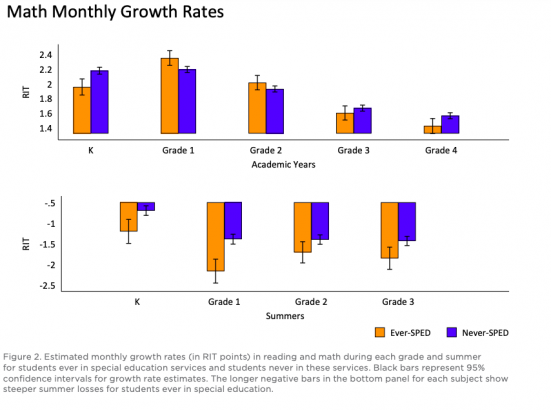Strong gains, quick losses: New research on students with disabilities finds conventional data hides both opportunity and risk
Beth Hawkins | June 10, 2021
Your donation will help us produce journalism like this. Please give today.
A new report from the assessment group NWEA underscores two findings that could inform how schools support children with disabilities going forward. Students receiving special education services often make more academic growth during a single school year than their typically abled peers, but are at substantially higher risk of losing ground during summer break.
If students with disabilities fell behind during the pandemic the same way they do between school years, they are particularly vulnerable to what researchers call COVID Slide. To help address this, the report’s authors, together with the National Center for Learning Disabilities, have a number of recommendations.
For the long term, they say, more research is needed to better understand the value of increased specialized summer programming — something many families must now fight to get. In the immediate future, however, they emphasize tutoring, high-quality curriculum and use of data to personalized instruction as schools welcome back children who may have received few specialized supports during the pandemic.
While a trove of evidence shows that students in special education overall score much lower than their peers on standardized tests, NWEA says the report is the first to examine growth during the school year and summer learning loss specifically among children with disabilities.
NWEA’s MAP test, formerly known as the Measures of Academic Progress, is typically given in the fall and spring, and sometimes more often. Administered online, it measures how far ahead or behind their grade level a student is, revealing which specific skills they have not mastered, as well as academic growth made in a single year.
In contrast, state exams given in the spring provide a snapshot showing where students score in relation to what is expected for their grade. Because these yearly tests capture neither the strong academic growth among children with disabilities nor its rapid loss, they may obscure an important element to making special education more effective.
The MAP scores student progress according to units NWEA calls RITs — the rough equivalent of inches or feet on a yardstick. During the summer, students with disabilities lose 1.2 to 2.1 RITs per month, compared with -0.4 to -0.8 for non-disabled students.
Researchers Elizabeth Barker and Angela Johnson drew their conclusions from data gathered between 2014 and 2019 from 4,228 students in kindergarten through fourth grade in 109 schools. They divided students into two groups — ever-SPED and never-SPED — based on whether each child had received any special education services at any point. The sample, they note, is not representative because the information came from schools that were willing to share their data.
In addition to finding that students with disabilities may both gain and lose academic skills more quickly than their classmates, the researchers found that children in special education start kindergarten at roughly the national mean but fall behind over the course of the year. The gap that opens between them and typically developing children widens between kindergarten and fourth grade.
In its accompanying set of recommendations, the National Center for Learning Disabilities notes that $3 billion of the $125 billion in Elementary and Secondary School Emergency Relief pandemic recovery funds is earmarked specifically for bolstering services for children with disabilities. Many of the strategies outlined are also being advanced by education advocacy groups as steps that will help all students catch up in the wake of COVID-19.
Among them: States, districts and schools should invest in high-quality curriculum backed by evidence of effectiveness — particularly for students with disabilities. They should consider offering more learning time and research-backed tutoring. Using good data to personalize instruction is key to serving children with disabilities, as is embracing universal design, a strategy of modifying lessons to make them accessible to any student.
Because of the trauma and mental health challenges families have experienced during the pandemic, it’s likely to be difficult for educators to discern the difference between an educational disability and an emotional or behavioral challenge, the center warns. Schools should strengthen both their capacity to perform good special ed evaluations and social-emotional supports for all children — especially those from systemically marginalized communities.
Finally, schools should step up family engagement and solicit input from parents of children with disabilities, possibly by partnering with organizations that are already deeply involved in their communities.
The report includes links to numerous resources to help with the implementation of each recommendation.
This article was published in partnership with The 74. Sign up for The 74’s newsletter here.


